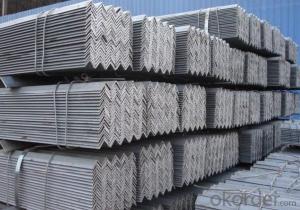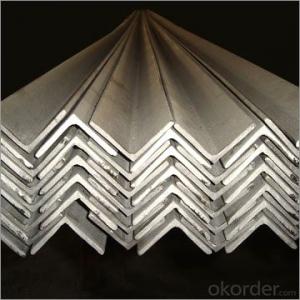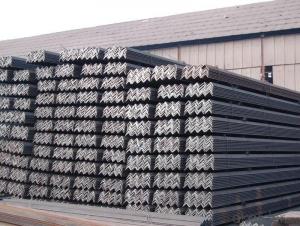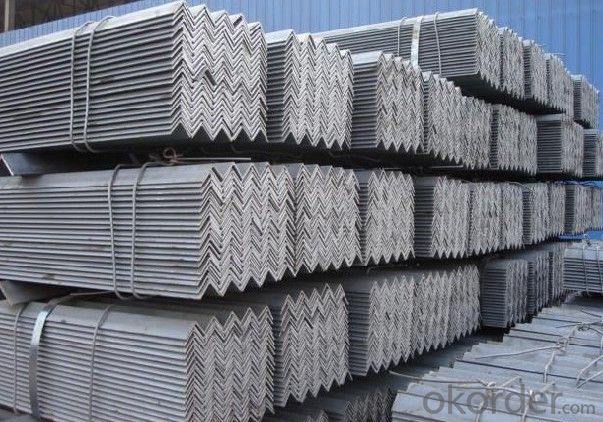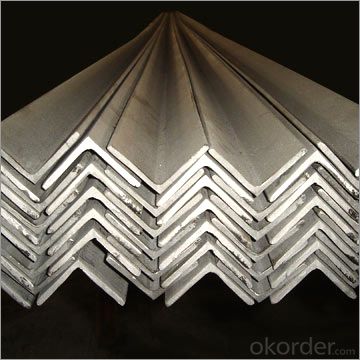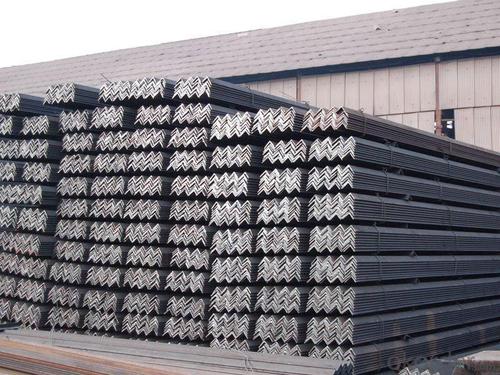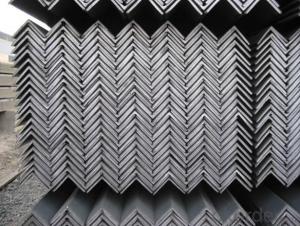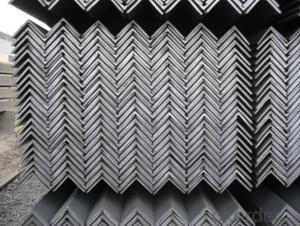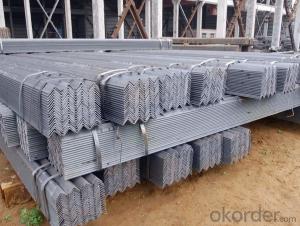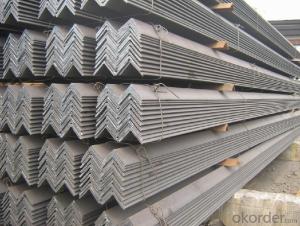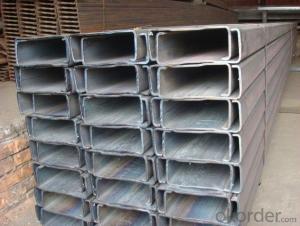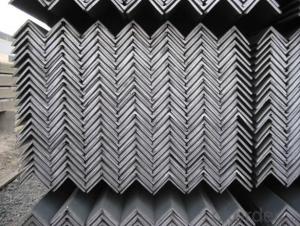Angle steel 20-250
- Loading Port:
- China Main Port
- Payment Terms:
- TT OR LC
- Min Order Qty:
- -
- Supply Capability:
- -
OKorder Service Pledge
OKorder Financial Service
You Might Also Like
Angle Steel Details:
| Minimum Order Quantity: | 25mtons | Unit: | m.t. | Loading Port: | China Main Port |
| Supply Ability: | 80000-100000MTS/YEAR | Payment Terms: | TT or LC |
Product Description:
Specifications of Angle Steel
1. Invoicing on theoretical weight or actual weight as customer request
2. Length: 6m, 9m, 12m as following table
3. Sizes

Sizes: 25mm-250mm | ||
a*t | ||
25*2.5-4.0 | 70*6.0-9.0 | 130*9.0-15 |
30*2.5-6.6 | 75*6.0-9.0 | 140*10-14 |
36*3.0-5.0 | 80*5.0-10 | 150*10-20 |
38*2.3-6.0 | 90*7.0-10 | 160*10-16 |
40*3.0-5.0 | 100*6.0-12 | 175*12-15 |
45*4.0-6.0 | 110*8.0-10 | 180*12-18 |
50*4.0-6.0 | 120*6.0-15 | 200*14-25 |
60*4.0-8.0 | 125*8.0-14 | 250*25 |
5. Payment terms:
1).100% irrevocable L/C at sight.
2).30% T/T prepaid and the balance against the copy of B/L.
3).30% T/T prepaid and the balance against L/C
6.Material details:
Alloy No | Grade | Element (%) | | ||||
C | Mn | S | P | Si | | ||
| | |||||||
|
|
|
|
|
|
| |
Q235 | B | 0.12—0.20 | 0.3—0.7 | ≤0.045 | ≤0.045 | ≤0.3 | |
|
|
|
|
|
|
| |
Alloy No | Grade | Yielding strength point( Mpa) | | ||||
Thickness (mm) | | ||||||
≤16 | >16--40 | >40--60 | >60--100 | | |||
≥ | | ||||||
|
|
|
|
|
| | |
Q235 | B | 235 | 225 | 215 | 205 | | |
Alloy No | Grade | Tensile strength (Mpa) | Elongation after fracture (%) | | |||
Thickness (mm) | | ||||||
| ≤16 | >16--40 | >40--60 | >60--100 | | ||
≥ | | ||||||
|
|
|
|
|
|
| |
Q235 | B | 375--500 | 26 | 25 | 24 | 23 | |
Usage & Applications of Angle Steel
According to the needs of different structures, Angle can compose to different force support component, and also can be the connections between components. It is widely used in various building structures and engineering structures such as roof beams, bridges, transmission towers, hoisting machinery and transport machinery, ships, industrial furnaces, reaction tower, container frame and warehouse etc.
Packaging & Delivery of Angle Steel
1. Packing: it is nude packed in bundles by steel wire rod
2. Bundle weight: not more than 3.5MT for bulk vessel; less than 3 MT for container load
3. Marks:
Color marking: There will be color marking on both end of the bundle for the cargo delivered by bulk vessel. That makes it easily to distinguish at the destination port.
Tag mark: there will be tag mark tied up on the bundles. The information usually including supplier logo and name, product name, made in China, shipping marks and other information request by the customer.
If loading by container the marking is not needed, but we will prepare it as customer request.
Production flow of Angle Steel
Material prepare (billet) —heat up—rough rolling—precision rolling—cooling—packing—storage and transportation
- Q: How do steel angles perform under seismic loads?
- Steel angles are widely used in construction to provide support and reinforcement for structures. Their inherent properties and design flexibility make them highly effective in seismic conditions. A major advantage of steel angles is their impressive strength-to-weight ratio. This enables them to withstand the intense forces and movements caused by earthquakes without significant deformation or failure. The angle's compact shape also helps distribute the load efficiently, reducing stress concentrations and potential weak points. Furthermore, steel angles can be easily connected to other structural elements, creating a robust and reliable connection system. This is crucial in seismic design, where the ability to transfer forces and accommodate movements is vital. To further enhance their performance under seismic loads, steel angles can be designed with specific features. For example, the addition of stiffeners or bracing elements can increase their resistance to lateral forces, minimizing the risk of buckling or collapse. Using thicker and stronger steel grades can also improve their capacity to absorb and dissipate seismic energy. Various seismic design codes and standards provide guidelines and requirements for the use of steel angles in earthquake-resistant structures. These codes consider factors such as maximum stress levels, connection details, and overall structural behavior during seismic events. In conclusion, steel angles excel in seismic conditions due to their high strength-to-weight ratio, efficient load distribution, and design flexibility. When properly designed and implemented, they effectively withstand the forces and movements generated during earthquakes, ensuring the structural integrity and safety of buildings.
- Q: How do steel angles perform in high-humidity environments?
- Due to their corrosion-resistant properties, steel angles exhibit excellent performance in high-humidity environments. While the air's moisture content often causes metals to rust and corrode, steel angles are specifically engineered to withstand these conditions. Typically manufactured using stainless steel or galvanized steel, both materials possess a protective layer that effectively hinders rust formation. Consequently, steel angles are exceptionally well-suited for utilization in regions with high humidity, such as coastal areas or industrial settings where moisture is abundant. Moreover, their durability and extended lifespan further contribute to their exceptional performance in high-humidity environments.
- Q: Do steel angles require maintenance?
- Yes, steel angles do require maintenance. While steel is a durable material, it is still susceptible to rust and corrosion, especially when exposed to moisture or harsh environmental conditions. Regular maintenance is necessary to prevent these issues and ensure the longevity of steel angles. Some common maintenance practices include inspecting for any signs of rust or damage, cleaning the surface to remove dirt and debris, and applying protective coatings or paints to prevent corrosion. Additionally, proper storage and handling of steel angles can also contribute to their maintenance. It is important to follow manufacturer guidelines and consult with professionals to determine the specific maintenance requirements for steel angles in different applications.
- Q: What are the different types of steel angles used in engineering?
- There are several types of steel angles commonly used in engineering applications, including equal angles, unequal angles, L-shaped angles, and T-shaped angles. Each type has its own unique properties and uses, with equal angles being suitable for general structural purposes, unequal angles used for supporting various loads, L-shaped angles for framing and bracing, and T-shaped angles for connecting and supporting components.
- Q: How do you calculate the effective length of a steel angle?
- To calculate the effective length of a steel angle, you need to consider its end conditions and support conditions. It is determined by analyzing the buckling behavior and stability of the angle under different loading conditions. This involves considering factors such as fixed or pinned ends, bracing conditions, and the angle's geometric properties. By applying relevant formulas or structural analysis methods, you can determine the effective length and use it to assess the angle's structural stability and design requirements.
- Q: What are the different types of steel angles?
- There are several different types of steel angles, including equal angles, unequal angles, L-shaped angles, and T-shaped angles.
- Q: Are steel angles available in pre-galvanized form?
- Yes, steel angles are available in pre-galvanized form.
- Q: What are the different types of connections used for steel angles in architectural applications?
- There are several types of connections used for steel angles in architectural applications. Some common types include bolted connections, welded connections, and riveted connections. Bolted connections involve using bolts to secure the steel angles together, while welded connections involve fusing the steel angles using heat. Riveted connections, on the other hand, involve using rivets to connect the steel angles together. Each type of connection has its own advantages and disadvantages, and the choice depends on factors such as the load requirements, aesthetics, and ease of construction.
- Q: Can steel angles be drilled or cut?
- Yes, steel angles can be drilled or cut. Steel angles are a versatile structural material that is commonly used in various construction and manufacturing projects. They can be easily drilled to create holes for bolts, screws, or other fasteners. Additionally, steel angles can be cut to specific lengths or shapes using tools such as saws, plasma cutters, or shears. The ability to drill or cut steel angles makes them highly adaptable and suitable for a wide range of applications.
- Q: What are the limitations of using steel angles in highly corrosive or chemical environments?
- The limitations of using steel angles in highly corrosive or chemical environments stem from the inherent nature of steel and its vulnerability to corrosion. To begin with, steel angles are primarily composed of carbon steel, which has a tendency to rust when exposed to moisture or chemicals. In environments with high corrosion potential, such as those containing acids, alkalis, or saltwater, the steel angles may corrode at an accelerated rate, which can compromise their structural integrity. Additionally, these steel angles may also experience pitting corrosion in such environments. Pitting corrosion occurs when localized chemical reactions result in the formation of small pits or holes on the steel surface. This phenomenon weakens the angles and diminishes their load-bearing capacity. Another drawback is that steel angles may lack resistance to specific chemicals or substances. Certain chemicals can trigger reactions with the steel, leading to degradation or even catastrophic failure. For example, strong acids or bases can inflict severe damage on the steel angles, potentially resulting in structural collapse. Moreover, steel angles in corrosive environments often require supplementary protective measures like coatings or corrosion inhibitors to enhance their resistance. However, implementing these additional measures can escalate the cost and maintenance demands of the structure. To summarize, while steel angles find widespread use in various applications, their suitability in highly corrosive or chemical environments is limited due to their susceptibility to corrosion and potential chemical reactions. It is crucial to consider alternative materials or employ protective measures to ensure the angles' structural integrity and longevity in such environments.
Send your message to us
Angle steel 20-250
- Loading Port:
- China Main Port
- Payment Terms:
- TT OR LC
- Min Order Qty:
- -
- Supply Capability:
- -
OKorder Service Pledge
OKorder Financial Service
Similar products
Hot products
Hot Searches
Related keywords
